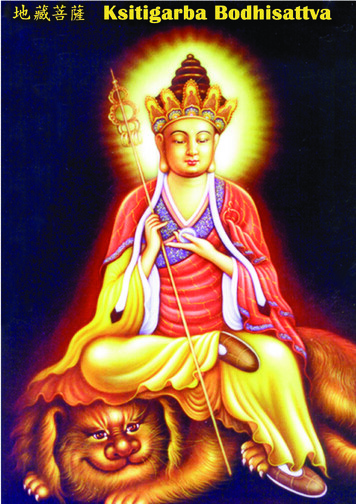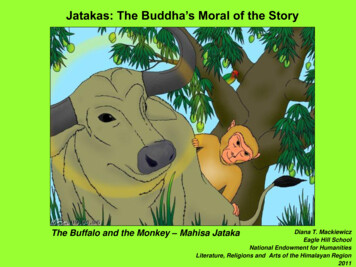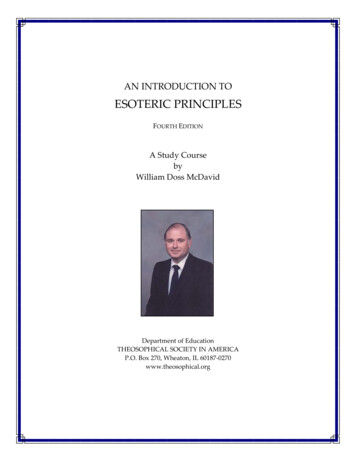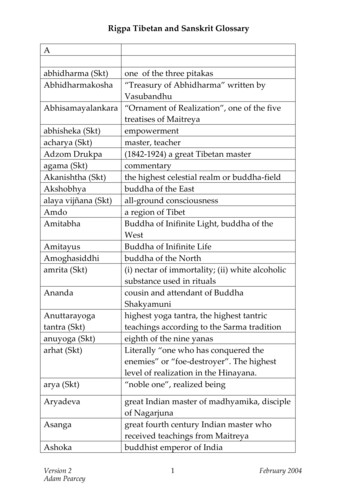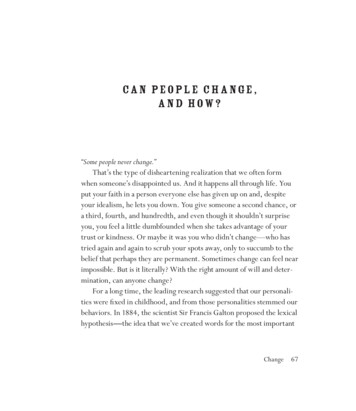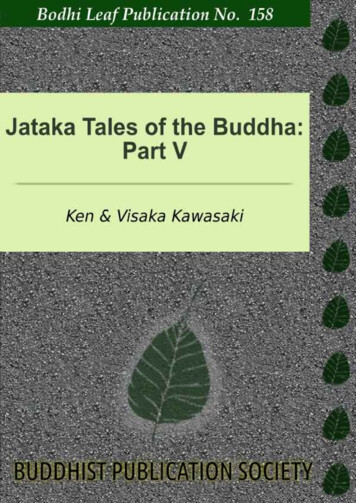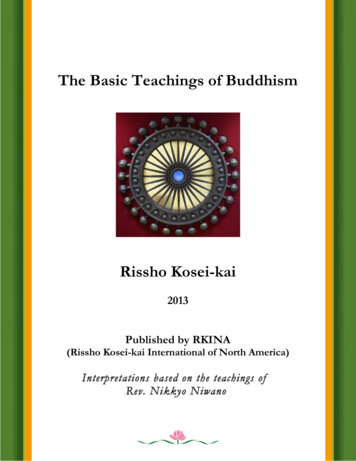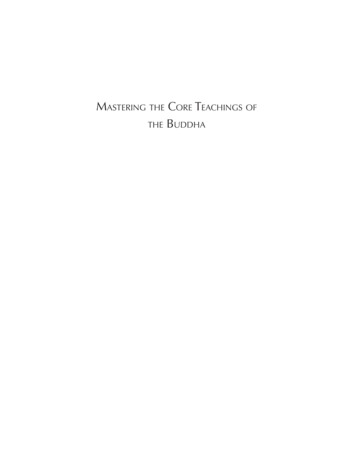
Transcription
Table of ContentsTitle PageCopyright EFOURFIVESIXSEVENEIGHTNINETENMINDFULGLOSSARY
OTHER BOOKS BY THICH NHATHANHAngerGoing HomeFragrant Palm LeavesBeing PeaceThe Blooming of a LotusBreathe! You Are AliveCall Me By My True NameCultivating the Mind of LoveFor a Future to Be PossibleThe Heart of UnderstandingThe Long Road Turns to JoyLove in ActionThe Miracle of MindfulnessNo Death, No FearOld Part, White CloudsPeace Is Every StepPresent Moment, Wonderful MomentThe Sun My HeartTaming the Tiger WithinTouching PeaceTransformation and Healing
Riverhead Books, New York
THE B ERKLEY PUB LISHING G ROUPPublished by the Penguin G roupPenguin G roup (USA) Inc.375 Hudson Street, New York, New York 10014, USAP enguin Group (Canada), 90 Eglinton Avenue East, Suite 700,Toronto, Ontario M4P 2Y3, Canada(a division of P earson P enguin Canada Inc.)P enguin Books Ltd., 80 Strand, London WC2R ORL, EnglandP enguin Group Ireland, 25 St. Stephen’ s Green, Dublin 2, Ireland(a division of P enguin Books Ltd.)P enguin Group (Australia), 250 Camberwell Road,Camberwell,Victoria 3124,Australia (a division of P earson Australia Group P ty. Ltd.)P enguin Books India P vt. Ltd., 11 Community Centre, P anchsheelP ark, NewDelhi—110 017, IndiaP enguin Group (NZ), cnr Airborne and Rosedale Roads, Albany,Auckland 1310,New Zealand (a division of P earson New Zealand Ltd.)P enguin Books (South Africa) (P ty.) Ltd., 24 Sturdee Avenue,Rosebank,Johannesburg 2196, South AfricaP enguin Books Ltd., Registered Offices: 80 Strand, LondonWC2R 0RL, EnglandThe publisher does not have any control over and does not assume anyresponsibility for author or third-party websites or their content.Copyright 1995, 2007 by Thich Nhat HanhAll rights reserved.No part of this book may be reproduced, scanned, or distributed in anyprinted orelectronic form without permission. P lease do not participate in orencourage piracyof copyrighted materials in violation of the author’ s rights. P urchaseonlyauthorized editions.RIVERHEAD is a registered trademark of P enguin Group (USA) Inc.
The RIVERHEAD logo is a trademark of P enguin Group (USA) Inc.Nh’ ăt Hanh, Thích.Living Buddha, living Christ / Thich Nhat Hanh.p. cm.eISBN : 978-1-101-00661-0BR128.B8N43 1995294.3’ 37—dc20 95-24014 CIPhttp://us.penguingroup.com
ACKNOWLEDGMENTSI am grateful to my friends Martin Pitt, Mobi Warren,and Arnold Kotler for their valuable time and energy inhelping to transcribe tapes and edit this book, making itinto a wonderful instrument for dialogue.
FOREWORDTwice in this book Thich Nhat Hanh puts before us apowerful image of Christian legend: In midwinter, St.Francis is calling out to an almond tree, “Speak to me ofGod!” and the almond tree breaks into bloom. It comesalive. There is no other way of witnessing to God butby aliveness. With a fine instinct, Thich Nhat Hanhtraces genuine aliveness to its source. He recognizes thatthis is what the biblical tradition calls the Holy Spirit.After all, the very word “spirit” means “breath,” and tobreathe means to live. The Holy Spirit is the breath ofdivine life.This conjures up the Bible story of creation: In thebeginning, the Spirit of God—always feminine in theBible—hovers like a mother bird over the lifeless chaos,brooding and bringing forth life in all its forms anddegrees. “For the Spirit of the Lord fills the wholeuniverse and holds all things together .” (Wisdom 1:7)At the end of this creation myth, we see God, in atouching image, breathe life into the nostrils of the still-
lifeless human figure formed out of earth in God’s ownimage. And so we humans come alive. From the biblicalperspective, there has never been a human being who isnot alive with God’s own life breath.We Christians have no monopoly on the Holy Spirit:“All those who are led by the Spirit of God are[daughters and] sons of God.” (Romans 8:14) Nowonder, then, that a Buddhist who is not afraid of thepain it brings to be truly alive—birth pain, growing pain—should recognize the Holy Spirit as the ultimatesource of all aliveness. “The Spirit blows where shewills.” (John 3:8) And no wonder that alive Christiansrecognize their sisters and brothers in the Holy Spiritanywhere.“Nhat Hanh is my brother,” wrote Thomas M erton.“We are both monks, and we have lived the monasticlife about the same number of years. We are both poets,both existentialists. I have far more in common withNhat Hanh than I have with many Americans.” Thatwas written when the two peacemakers confrontedtogether the catastrophe of the Vietnam War. It was atthat time that I myself had the privilege of meetingThich Nhat Hanh, known to friends and students as
Thây (teacher), and I recognized in him a brother in theSpirit.Great was my joy to find on the very first page ofthis book a reference to Thây’s sharing the Eucharistwith Dan Berrigan. On one occasion, this took place inthe small student’s room I occupied at ColumbiaUniversity. As one of the sacred readings that evening,Thây recited the Heart Sutra, the most important Zenscripture, in Vietnamese. It was on April 4, 1968. Howcould I forget that date! Afterwards we went to listen toa lecture by Hans Küng, but the event was interruptedby the shattering news that Dr. M artin Luther King, Jr.,had been assassinated.The ritual we had celebrated earlier that evening hadonce again been reenacted in history: “Greater love noone has but to lay down one’s life for one’s friends.”(John 15:13) Jesus had done this 2,000 years ago;M artin had done it today; and Thây, in risking his ownlife to speak out uncompromisingly for peace inVietnam, was allowing himself to walk in the samedirection. “Nhat Hanh is a free man who has acted as afree man in favor of his brothers, moved by the spiritualdynamic of a tradition of religious compassion,”
Thomas M erton wrote. “We cannot let him go back toSaigon to be destroyed while we sit here cherishing thewarm humanitarian glow of good intentions and worthysentiments.” In the end, Thây was spared. Althoughunable to return to Vietnam, he has lived in exile eversince. The roots of Living Buddha, Living Christ goback to that time when, in the face of death, humanhearts were most alive.“It is safer to approach God through the Holy Spiritthan through theology,” Thây writes. And yet he is atheologian in the deepest sense: He speaks of God outof his own living experience. And he speaks withenthusiasm—with the voice of the divine Spirit in hisown heart. If we listen attentively, we will heartraditional truths expressed in startling new ways. Andwe might be surprised by Thây’s sure sense foressentials. For Christian readers, it would be a great lossto overlook this voice of insight and compassion,insisting instead on academic niceties and theologicalprecision.“Discussing God is not the best use of our energy,”Thich Nhat Hanh writes. “If we touch the Holy Spirit,we touch God not as a concept but as a living reality.”
With a gentle but firm hand, this monk leads us againand again from theory to practice. He has deep respectfor concepts, but as a means, not an end. The Zentradition has developed a rich and nuanced terminology,but its emphasis on practice makes it less likely thatone will get stuck in notions. Thây insists: “Reality isfree from all notions. It is our duty to transcendwords and concepts to be able to encounter reality.”He continues: “When we see someone overflowingwith love and understanding, someone who is keenlyaware of what is going on, we know that they are veryclose to the Buddha and to Jesus Christ.” How wouldyou feel if you met a person like that? Overjoyed? Ofcourse. Comfortable. Perhaps not. I have had theprivilege of encountering men and women close to theliving Buddha, the living Christ—some of them worldfamous, others completely unknown; it makes nodifference. Their very presence awakens us andchallenges our complacency.Reading Living Buddha, Living Christ, I felt the samechallenge. I am not referring to the few passages thatcriticize Christian (or rather un-Christian) narrowness,exclusivism, or sexism. Any Christian who strives to
follow Christ will have voiced those criticisms long agoand possibly less gently. The challenge I felt waspersonal. It came not from anything Thây said, butfrom his silence, from between the lines. I felt a bit likethe almond tree confronted by St. Francis. “Startblooming, frozen Christian!” the mystic AngelusSilesius called out. “Springtime is at hand. When willyou ever bloom if not here and now?” Thich NhatHanh’s words entered me like a Zen koan: Speak to meof the unspeakable, and not with words. “Speak to meof God!” This is the challenge Thich Nhat Hanh offersus: Come alive, truly alive!—Brother David Steindl-Rast, O.S.B.Big Sur, CaliforniaTrinity Sunday 1995
INTRODUCTIONI n Living Buddha, Living Christ, Thich Nhat Hanhexpresses deep respect and appreciation for manyelements of Christian tradition—not only for theteachings of Jesus but even for the concept of theTrinity and the possibilities for experiencing the loveand compassion that many Christians and certainChristian communities offer. Fortunately for hisreaders, however, Thich Nhat Hanh does not take theeasy way out of ecumenical discussion by ignoringdisagreement. He also points out elements of Christiantradition that foster religious intolerance and have led toreligious hatred. Thich Nhat Hanh speaks of this fromhis own experience. From the time the French whocolonized Vietnam allied themselves with Christianmissionary efforts to the crisis of 1963 when PresidentDiêm passed a law prohibiting his people fromcelebrating the Buddhist national holiday, manyVietnamese have understandably associated Christianitywith foreign attempts to establish political and culturaldomination.
With his characteristic directness, Thich Nhat Hanhgoes to the heart of the matter. After examining theparallels between the theology of the Trinity and theBuddhist concept of “interbeing,” he takes issue withthe man regarded by millions as the foremost exponentof the Christian tradition—Pope John Paul II. In hisrecent book, Crossing the Threshold of Hope, John PaulII states that:Christ is absolutely original and absolutely unique.If He were only a wise man like Socrates, if Hewere a “prophet” like M ohammed, if He were“enlightened” like Buddha, without any doubt Hewould not be what He is. He is the one mediatorbetween God and humanity.Quoting this passage, Thich Nhat Hanh comments :This statement does not seem to reflect the deepmystery of the oneness of the Trinity. It also does
not reflect the fact that Christ is also the Son ofM an. All Christians, while praying to God,address Him as Father. Of course Christ is unique.But who is not unique? Socrates, M ohammed, theBuddha, you, and I are all unique. The idea behindthe statement, however, is the notion thatChristianity provides the only way of salvationand all other religious traditions are of no use. Thisattitude excludes dialogue and fosters religiousintolerance and discrimination. It does not help.As one engaged in studying Christian tradition whoalso participates in Christian practice, I find myselfagreeing with Thich Nhat Hanh at this and nearly everysignificant turn of Living Buddha, Living Christ. Yetmy agreement does not come from immersion inBuddhist tradition—on the contrary, it comes fromexploration into the earliest history of Christianity. Asa graduate student, I was surprised to learn of adiscovery that is still transforming our understanding ofChristianity—and its mysterious founder. In 1947,when a Bedouin villager named M ohammed Ali wasdigging for bird-lime fertilizer under a cliff near the town
of Nag Hammadi in Upper Egypt, he struck somethingunderground. M oments later he unearthed a sealedearthenware jar, six feet high, and inside were thirteenancient codices, bound in tooled gazelle leather. Thecollection included an astonishing number of ancientChristian gospels and other writings, includingdialogues, conversation, and visions attributed to Jesusand His disciples. One of these was the Gospel ofThomas, which Helmut Koester, Professor of NewTestament at Harvard University, dates to c.50 C.E.—some twenty years before any of the New Testamentgospels were written. Others were the Gospel of Philip,the Dialogue of the Savior, the Secret Book of John, andthe Apocalypse of Paul—some fifty-two texts in all.The books apparently were salvaged from the library ofthe earliest Christian monastery in Egypt after thearchbishop of Alexandria ordered the monks to destroyall books he deemed “heretical” —that is, Christiansources not endorsed by the clerical authorities.Voyaging from these gnostic Christian texts to thework of Thich Nhat Hanh, I feel I am in familiarterritory. During the formative era of the Christianmovement (50-150 C.E.), many Christians spoke from aperspective similar to his, seeing Jesus as one throughwhom the divine was manifested, and through whose
example and teaching they could hope for similarenlightenment. But the majority of Christian churchleaders rejected such teaching not only for the“blasphemy” of inviting each disciple to identify withChrist Himself but also for teaching what could proveconfusing or destabilizing to many church members.By investigating these long-hidden sources, wediscover that the early Christian movement containedenormously more diversity of viewpoint and practicethan most Christians later acknowledged or evenimagined. One need only listen to the words of theGospel of Thomas to hear how it resonates with theBuddhist tradition:Jesus said, “If those who lead you say to you,‘Look, the Kingdom is in the sky,’ then the birdsof the sky will get there first. If they say, ‘It is inthe sea,’ then the fish will get there first. Rather,the Kingdom is inside of you, and it is outside ofyou. When you come to know yourselves, thenyou will become known, and you will realize that itis you who are the children of the living Father.But if you will not know yourselves, then youdwell in poverty, and it is you who are thatpoverty” (emphasis added).
According to the Gospel of Thomas, that “livingJesus” indeed offers access to God, but instead ofclaiming to be the “only begotten Son of God” (as theNew Testament Gospel of John will later insist), Hereveals that “it is you who are the children of God.”This gospel is attributed to “Thomas the twin.” Thename Thomas in Hebrew literature means “twin.” DidJesus, then, have a twin brother? I suggest instead thatthe attribution, meant symbolically, directs the reader todiscover that he—or she—is, indeed, at a deep level,Jesus’ “twin”—and fellow child of God. As the gospelcloses, Jesus goes on to speak directly to Thomas:Whosoever drinks from my mouth will become as Iam; and I will become that person; and themysteries will be revealed to him (emphasisadded).According to The Book of Thomas the Contender,another text from the same discovery, Jesus speaks toThomas—that is, to the reader—in these words:
Since it has been said that you are my twin and mytrue companion, it is not fitting for you to beignorant of yourself. So while you accompany me,although you do not yet understand it, you havealready come to know, and you will be called “theone who knows himself.” For whoever has notknown himself knows nothing, but he who hasknown himself has already understood the depthof all things.While the New Testament gospels speak of Jesus asthe only door to salvation, the only path (“I am theway . no one come to the Father except through me”[John 14:6]), another of these texts, The Teaching ofSilvanus, speaks quite differently:Knock upon yourself as upon a door, and walkupon yourself as on a straight road. For if youwalk on that path, you cannot go astray; and whenyou knock on that door, what you open foryourself shall open.
These ancient gospels tend to point beyond faithtoward a path of solitary searching to findunderstanding, or gnosis. The Gospel of Thomasacknowledges that such exploration is simultaneouslyfrustrating, troubling, and surprising:Let the one who seeks not stop seeking until hefinds. When he finds, he shall be troubled. When hebecomes troubled, he will be amazed, and shallcome to transcend all things.This gospel warns, too, that what is at stake is one’sdeepest well-being, or else one’s destruction:Jesus said, “If you bring forth what is within you,what you bring forth will save you. If you do notbring forth what is within you, what you do notbring forth will destroy you.”Although church leaders also charged gnosticChristians with spiritual elitism and with solipsism, thesources discovered at the Nag Hammadi, like Buddhist
sources, direct the disciple toward loving compassionfor others: According to the Gospel of Thomas, Jesussays, “Love your brother as the apple of your eye.”The gnostic Gospel of Truth exhorts the hearer toSpeak of the truth with those who search for it,and of knowledge to those who have committed asin in their error. M ake firm the foot of those whohave stumbled; give rest to those who are weary,and raise up those who wish to rise, and awakenthose who sleep.As I read Living Buddha, Living Christ, I wondered:Does Thich Nhat Hanh know the Gospel of Thomasand other gnostic sources or did he choose the term“living Christ”—a term more characteristic of gnostictexts than of the New Testament—by a kind ofspiritual intuition? In either case, those who are morefamiliar than I am with Buddhist tradition, andespecially those more experienced in meditation andcontemplation, will surely notice in these ancientChristian sources many more resonances than I canmention here. Comparative study of Buddhism andearly (gnostic) Christianity has barely begun. The
publication of Living Buddha, Living Christ presents anopportune moment to deepen our understanding.—Elaine PagelsPrinceton, New JerseyJune 23, 1995
ONEBE STILL AND KNOW
RELIGIOUS LIFE IS LIFETwenty years ago at a conference I attended oftheologians and professors of religion, an IndianChristian friend told the assembly, “We are going tohear about the beauties of several traditions, but thatdoes not mean that we are going to make a fruit salad.”When it came my turn to speak, I said, “Fruit salad canbe delicious! I have shared the Eucharist with FatherDaniel Berrigan, and our worship became possiblebecause of the sufferings we Vietnamese and Americansshared over many years.” Some of the Buddhistspresent were shocked to hear I had participated in theEucharist, and many Christians seemed truly horrified.To me, religious life is life. I do not see any reason tospend one’s whole life tasting just one kind of fruit. Wehuman beings can be nourished by the best values ofmany traditions.Professor Hans Küng has said, “Until there is peacebetween religions, there can be no peace in the world.”People kill and are killed because they cling too tightlyto their own beliefs and ideologies. When we believe
that ours is the only faith that contains the truth,violence and suffering will surely be the result. Thesecond precept of the Order of Interbeing, foundedwithin the Zen Buddhist tradition during the war inVietnam, is about letting go of views: “Do not think theknowledge you presently possess is changeless,absolute truth. Avoid being narrow-minded and boundto present views. Learn and practice nonattachmentfrom views in order to be open to receive others’viewpoints.” To me, this is the most essential practiceof peace.
DIALOGUE: THE KEY TO PEACEI have been engaged in peace work for more thanthirty years: combating poverty, ignorance, and disease;going to sea to help rescue boat people; evacuating thewounded from combat zones; resettling refugees;helping hungry children and orphans; opposing wars;producing and disseminating peace literature; trainingpeace and social workers; and rebuilding villagesdestroyed by bombs. It is because of the practice ofmeditation—stopping, calming, and looking deeply—that I have been able to nourish and protect the sourcesof my spiritual energy and continue this work.During the war in Vietnam, I saw communists andanti-communists killing and destroying each otherbecause each side believed they had a monopoly on thetruth. M any Christians and Buddhists in our countrywere fighting each other instead of working together tostop the war. I wrote a booklet entitled “Dialogue: TheKey to Peace,” but my voice was drowned out by thebombs, mortars, and shouting. An American soldier
standing on the back of a military truck spit on the headof my disciple, a young monk named Nhât Tri. Thesoldier must have thought we Buddhists wereundermining America’s war effort or that my disciplewas a communist in disguise. Brother Nhat Tri becameso angry that he thought about leaving the monasteryand joining the National Liberation Front. Because I hadbeen practicing meditation, I was able to see thateveryone in the war was a victim, that the Americansoldiers who had been sent to Vietnam to bomb, kill,and destroy were also being killed and maimed. I urgedBrother Nhât Tri to remember that the G.I. was also awar victim, the victim of a wrong view and a wrongpolicy, and I urged him to continue his work for peaceas a monk. He was able to see that, and he became oneof the most active workers in the Buddhist School ofYouth for Social Service.In 1966, I came to North America to try to helpdissolve some of the wrong views that were at the rootof the war. I met with hundreds of individuals and smallgroups, and also with members of Congress andSecretary of Defense Robert M cNamara. The visit wasorganized by the Fellowship of Reconciliation, aninterfaith peace organization, and many activeChristians helped me in these efforts, among them Dr.
M artin Luther King, Jr., Father Thomas M erton, andFather Daniel Berrigan. These were, in fact, theAmericans I found it easiest to communicate with.
TOUCHING JESUSBut my path to discovering Jesus as one of myspiritual ancestors was not easy. The colonization ofmy country by the French was deeply connected withthe efforts of the Christian missionaries. In the lateseventeenth century, Alexandre de Rhodes, one of themost active of the missionaries, wrote in hisCathechismus in Octo Dies Divisus: “Just as when acursed, barren tree is cut down, the branches that arestill on it will also fall, when the sinister and deceitfulSakya [Buddha] is defeated, the idolatrous fabricationsthat proceed from him will also be destroyed.” Later, inthe late 1950s and early 1960s, Catholic ArchbishopNgo Dinh Thuc, in his efforts to evangelize Vietnam,leaned heavily on the political power of his brother,President Ngo Dinh Diêm. President Diêm’s 1963decree prohibiting the celebration of Wesak, the mostimportant Buddhist national holiday, was the straw thatbroke our back. Tens of thousands of lay and ordainedBuddhists demonstrated for religious freedom, leadingto a coup d’état and the overthrow of the Diêm regime.In such an atmosphere of discrimination and injustice
against non-Christians, it was difficult for me todiscover the beauty of Jesus’ teachings.It was only later, through friendships with Christianmen and women who truly embody the spirit ofunderstanding and compassion of Jesus, that I havebeen able to touch the depths of Christianity. Themoment I met M artin Luther King, Jr., I knewI was in the presence of a holy person. Not just hisgood work but his very being was a source of greatinspiration for me. And others, less well known, havemade me feel that Lord Jesus is still here with us. HebeKohlbrugge, a beautiful Dutch woman who saved thelives of thousands of Jews during World War II, was socommitted to helping Vietnamese orphans and otherdesperately needy children during the war that when hergovernment refused to support this work, she gavethem back her World War II medals. Reverend HeinzKloppenburg, General Secretary of the GermanFellowship of Reconciliation, also supported ourhumanitarian work. He was so kind and so open, I onlyneeded to say a few words to him and he understoodeverything right away. Through men and women likethese, I feel I have been able to touch Jesus Christ and
His tradition.
REAL COMMUNICATIONOn the altar in my hermitage in France are images ofBuddha and Jesus, and every time I light incense, Itouch both of them as my spiritual ancestors. I can dothis because of contact with these real Christians. Whenyou touch someone who authentically represents atradition, you not only touch his or her tradition, youalso touch your own. This quality is essential fordialogue. When participants are willing to learn fromeach other, dialogue takes place just by their beingtogether. When those who represent a spiritual traditionembody the essence of their tradition, just the way theywalk, sit, and smile speaks volumes about the tradition.In fact, sometimes it is more difficult to have adialogue with people in our own tradition than withthose of another tradition. M ost of us have sufferedfrom feeling misunderstood or even betrayed by thoseof our own tradition. But if brothers and sisters in thesame tradition cannot understand and communicate witheach other, how can they communicate with thoseoutside their tradition? For dialogue to be fruitful, we
need to live deeply our own tradition and, at the sametime, listen deeply to others. Through the practice ofdeep looking and deep listening, we become free, able tosee the beauty and values in our own and others’tradition.M any years ago, I recognized that by understandingyour own tradition better, you also develop increasedrespect, consideration, and understanding for others. Ihad had a naive thought, a kind of prejudice inheritedfrom my ancestors. I thought that because Buddha hadtaught for forty-five years and Jesus for only two orthree, that Buddha must have been a more accomplishedteacher. I had that thought because I did not know theteachings of the Buddha well enough.One day when he was thirty-eight years old, theBuddha met King Prasenajit of Kosala. The king said,“Reverend, you are young, yet people call you ‘TheHighest Enlightened One.’ There are holy men in ourcountry eighty and ninety years old, venerated by manypeople, yet none of them claims to be the highestenlightened one. How can a young man like you makesuch a claim?”
The Buddha replied, “Your majesty, enlightenment isnot a matter of age. A tiny spark of fire has the powerto burn down a whole city. A small poisonous snakecan kill you in an instant. A baby prince has thepotentiality of a king. And a young monk has thecapacity of becoming enlightened and changing theworld.” We can learn about others by studyingourselves.For any dialogue between traditions to be deep, wehave to be aware of both the positive and negativeaspects of our own tradition. In Buddhism, for example,there have been many schisms. One hundred years afterthe passing of the Buddha, the community of hisdisciples divided into two parts; within four hundredyears, there were twenty schools; and since then, therehave been many more. Fortunately, these separationshave, for the most part, not been too painful, and thegarden of Buddhism is now filled with many beautifulflowers, each school representing an attempt to keepthe Buddha’s teachings alive under new circumstances.Living organisms need to change and grow. Byrespecting the differences within our own church andseeing how these differences enrich one another, we aremore open to appreciating the richness and diversity ofother traditions.
In a true dialogue, both sides are willing to change.We have to appreciate that truth can be received fromoutside of—not only within—our own group. If we donot believe that, entering into dialogue would be a wasteof time. If we think we monopolize the truth and westill organize a dialogue, it is not authentic. We have tobelieve that by engaging in dialogue with the otherperson, we have the possibility of making a changewithin ourselves, that we can become deeper. Dialogueis not a means for assimilation in the sense that one sideexpands and incorporates the other into its “self.”Dialogue must be practiced on the basis of “non-self.”We have to allow what is good, beautiful, andmeaningful in the other’s tradition to transform us.But the most basic principle of interfaith dialogue isthat the dialogue must begin, first of all, within oneself.Our capacity to make peace with another person andwith the world depends very much on our capacity tomake peace with ourselves. If we are at war with ourparents, our family, our society, or our church, there isprobably a war going on inside us also, so the mostbasic work for peace is to return to ourselves and createharmony among the elements within us—our feelings,
our perceptions, and our mental states. That is why thepractice of meditation, looking deeply, is so important.We must recognize and accept the conflicting elementsthat are within us and their underlying causes. It takestime, but the effort always bears fruit. When we havepeace within, real dialogue with others is possible.
INTERBEINGIn the Psalms, it says, “Be still and know that I amGod.” “Be still” means to become peaceful andconcentrated. The Buddhist term is samatha (stopping,calming, concentrating). “Know” means to acquirewisdom, insight, or understanding. The Buddhist term isvipasyana (insight, or looking deeply). “Lookingdeeply” means observing something or someone with somuch concentration that the distinction betweenobserver and observed disappears. The result is insightinto the true nature of the object. When we look into theheart of a flower, we see clouds, sunshine, minerals,time, the earth, and everything else in the cosmos in it.Without clouds, there could be no rain, and there wouldbe no flower. Without time, the flower could not bloom.In fact, the flower is made entirely of non-flowerelements; it has no indep
living Buddha, the living Christ—some of them world-famous, others completely unknown; it makes no difference. Their very presence awakens us and challenges our complacency. Reading Living Buddha, Living Christ, I felt the same challenge. I am not referring to the few passages that
